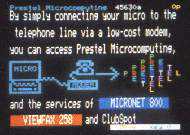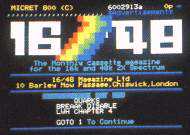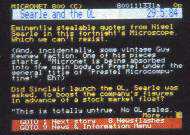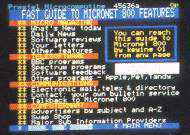Issue 5, July 1984 - Bulletin Boards
| Home | Contents | KwikPik |
This used to be the only way one could have a 'home' computer at all. The computer itself resided in a remote air-conditioned basement, and the user sat before an enormous electro- mechanical teletype machine. This would display the dialogue by printing on a continuous paper roll, with the consequence that operators of such a link gained a nickname from the intermittent 'hack hack hack' that distinguished their input from the regular chatter of the mainframe's reply. Not a lot of people know about that in these days of glass-faced terminals and thermal printers. And the people who do tap away in the wee small hours nowadays (to avoid the peak time charges) are much more likely to be communicating with their bank or checking the market figures than to be polishing their latest Fortran monsterpiece. In fact, modems are becoming consumer products at a rate fast approaching that which has put micros into the major retail chains. |
And about asterisking time, too, says British Telecom. PRESTEL ET ALBT is uncharacteristically at the fore-front of the new wave, with its Prestel database, the biggest and best anywhere. Prestel has over 300,000 pages of information, plus electronic mail and a link to the Telex system. So far this technical achievement has been typically British - that is to say, it's a commercial failure admired all over the world. However, the fortunes of Prestel and its myriad Information Providers (Prestel doesn't actually fill many of those pages, but rents them to the IPs) are on the wax. Subscribers to the system now number upwards of 40,000, and new IPs providing home banking, shopping and other such consumer oriented services are taking the subscriber base away from the travel agent specialist services and into the home of everyman.Many of these new services are launched with dedicated Prestel terminals which will do nothing else, but micro users can get access by various add-ons, and us Spectrum users have the superb Prism VTX5000 modem - winner of the BMA Peripheral of the Year award. Advertisements give the impression that this is a Micronet modem which can also get Prestel, but Micronet is a Prestel IP and not a separate system. Nor is it the only microcomputer interest section on Prestel. There's also Viewfax - a similar sort of electronic magazine with the same sort of features as Micronet, but not as extensive. The reason that Micronet is bigger is that it charges a subscription, and Viewfax doesn't. Both have daily news from the micro world, downloadable software, letters from readers, informative and humourous columnists (MicroMouse and MicroGnome), |
and sub-IPs
(usually advertisers).
Micronet subscribers could be forgiven for believing that Prestel is a
branch of Micronet instead of the other
way around, as they get sent straight to a
Micronet menu at log-on rather than the
Prestel menu that most subscribers get.
By the time you read this, however, a
computer interest menu will have taken
its place, giving a menu-selected route
to Viewfax as well. Unfortunately, this change goes beyond menus, and the Viewfax section will no longer be free to all Prestel subscribers. Viewfax is to get a share of the Micronet subscription, which will become the 'Prestel Microcomputing' subscription. This will not disturb Micronet subscribers much (as the cost will be the same) but non-netters will be entitled to feel that part of the Prestel service for which they are already paying Prestel subscriptions is being withdrawn. And when charges are introduced for the previously free electronic mail, as will shortly happen, you may hear loud disgruntlement from all and sundry. The costs involved consist of subscriptions, page charges, computer and telephone time charges. The last two can be avoided, or reduced, by using the system only after six and at weekends, and you need only pay page charges if you insist on seeing pages that the IP charges for, such as stock market information. The subscription to Prestel costs £5 a quarter, and the micro-computing section another £8. KEEP IT A SECRETYou won't be able to get access to Prestel without a subscription because it's protected by a password system. 'Hacking-in' is unrewarding because of the large number of possible password combinations which may consist of mixed upper, lower and numeric characters, giving over 16 million combinations in just four letters. Any stories you may hear about breaking into Prestel are due to subscribers being careless | |||||

| Well, it's a bit more tricky than this ad implies - but there's certainly a whole world of information out there. |

| |||||
| And speaking of ads, you can even find out more about competing titles to Your Spectrum. (What's this doing here? Ed.) | |||||||

| If it's news you're after, Micronet 800 will proivde you with all the 'dirt' on the Sinclair Research! |

| |||||
| Keying '01' will provide you with a fast menu of items you can access on Micronet. |
Micronet itself was not so lucky. The organisation has a couple of identities it loans out to exhibitors and magazine reviewers called 'Micronet 800 Demonstrations' and 'Micronet 800 Exhibitions'. Lots of people have had these numbers at one time or another, and Micronet changes the passwords incessantly to keep out the unauthorised. However, a recent exhibitor found the numbers easier to remember when taped to the front of the display machine, and rather more people than usual got a look at them! Ordinarily this would not have been a catastrophe, because the worst the interlopers should have been able to do was download a lot of expensive software from Micronet's own pages. This is theft, but Micronet presumably would not actually have to pay itself for what was taken. But the story goes on. The hackers apparently sent mailbox messages (purporting to be from Micronet) to legitimate 'netters asking them to send in their secret numbers to the Micronet Exhibitions mailbox number, to help in an effort to catch some naughty person sending lewd mailboxes. Some 'netters fell for the con, and shortly found themselves locked out of their own account; the hackers had logged on with their identity and changed the password. The moral of the story ... don't tell anyone your secrets! ON THE DOUBLEPrestel modems use a split baud rate of 1200/75, which has now become a European standard for such systems. German and Dutch Prestel-type databases can be called up on a Prestel modem, as can a growing host of domestic, private and commercial systems, provided you know the numbers. For once, perhaps, a 'standard' may be stuck to, and a Prestel modem looks like an investment for the future rather than a toy of the moment.The idea of the twin speeds is that Prestel needs to send a lot of data while you usuallly send only an occasional menu selection. However, the characters you transmit will be used to buy goods, book tickets - usually just |
spending money in some way - so they
are sent at a slower speed; presumably
less susceptible to corruption by line
noise. It makes sense, but there are
other standards. FROM LITTLE ACORNS ...The original standard for data links (ignoring Telex's 50 baud, which is still the international Telex standard) was limited less by the telephone system than by the speed of the mechanics of |
the teleprinter, and so remained at 110
baud long after the VDU took over.
Some systems still use 110 baud, but at
just 10 characters per second it's too
slow, and has been largely superseded
by 300 baud. The people who use 300 baud are the pre-consumer boom professionals and enthusiasts. A lot of the private and corporation databases are on 300 baud, especially in the USA, where breaking into private (or even government) | ||||||||||||||||||||||||||||||||||||||||||||||||||||||||||||||||||||||||||||||||||||
These bullwtin boards are all free British systems and can be accessed by anyone with the necessary equipment. | ||||||||||||||||||||||||||||||||||||||||||||||||||||||||||||||||||||||||||||||||||||||
|
The Interface 1 manual is very vague
on the RS232 link, possibly because it
tries to avoid making this admission.
Dr. Ian Logan's The Spectrum Microdrive Book has much more information,
including some on using the RS232 to
link other computers to the Spectrum,
but he does not mention modems. This
is very significant, for Logan helped to
write the Shadow ROM. The problem is simply that turning a |
So if you want to get onto 300 baud
with a Spectrum, you'll need not only a
modem, but a proper RS232 port.
There aren't that many available, but
Maplin has one that looks particularly
attractive; it's not only inexpensive, but
has its driving software in an on-board
EPROM. Unfortunately, the Maplin
representative who promised to send
me a unit for review was subsequently
nobbled by terrorists from the international VIC users underground -
otherwise, I would certainly have
received it by now. Maplin also does a
very cheap 300 baud modem, but both
items are in kit form. Maplin also
operates its own bulletin board. The add-on RS232 port that I have used is produced by U-Microcomputers, the Apple specialists. This is a much more costly unit, and requires a software driver to be loaded from tape ... on the other hand, it does come ready assembled. Using it requires some software ability on the part of the operator, and you'll have to use the dreaded soldering iron to deal with the baud rate selection, at least. However, it does give you lots of facilities, with two channels, split speeds, and lots of control over things you probably don't even want to know about. This is the one you'll need if you go for a multimode modem. IN THE MOOD FOR MODEMSOnce you have your RS232 port, the range of modems available borders on the vast, and will certainly attain true vastness soon. Super single chip versions are appearing on the market now which will cope with all the different baud rates and tone standards, all in one box; some of them are even BT approved! The best known and most talked about - probably because it was the first fairly cheap multimode - is the Minor Miracles WS2000, but a flock of similar items are chasing hard on its heels.The WS2000 will cope with 300, 600 and 1200 baud, both European and USA (same speed, different tones) standards. It will also work with the 1200/75 for Prestel; and it will also do it backwards, 75/1200, to communicate with a computer using a Prestel modem (110 baud usually uses the same tones as 300, so that, too, should work). Multimodes all cost over £100, but if you are happy to be restricted to 300 baud, then there are lots of modems at £50 or less available on the surplus market - or in kit form from Maplins. Points to look for are: Originate/answer - The box making the call should use 'originate' tones, the other uses 'answer'. If you want to have others phone you as well, then one of you will need both, otherwise 'originate- only' will do. US/Europe - Yanks use different tones and drive on the wrong side of the road. Don't complain to me. If you want onto US boards then you pay more. US standards | ||||||||||||||
| ||||||||||||||||
|
access hobbyist databases devoted to
interests varying from computing (of
course) to wife-swapping (it gets so boring in California). You can even get Prestel on 300 baud if you insist, but only
on a London phone number. For a computer nut, the amateur bulletin boards are more interesting than Prestel as a whole. Where else could you read a letter from Douglas Adams about how he is using a DEC Rainbow and Brainstorm to design the Hitch-hikers Guide video game, if not on Peter Tootill's board in Liverpool? Reading other people's mail (providing they don't flag it 'private') is allowable in the club-like recesses of a board, but could never be sanctioned by Prestel. While the individual boards are a lot smaller than Prestel, there are a lot more of them - especially if you are prepared to phone very long distance. Fred Brown's board in Hull has a list of foreign boards so long that downloading it will in itself cost as much as a call to the States. The individual nature of these enthusiast systems, and the free access to all comers, makes them adventurous when compared to the more regulated Prestel. HARDWARE SHOPPING LISTFirst the bad news. The RS232 port on Interface 1 is not quite the real article. It won't work with a proper full duplex modem, as used by almost all remote systems. |
byte of data into a stream of bits or, conversely, assembling a stream of bits into
a byte, requires the personal attention of
the Spectrum's CPU, and it can't do
both at once. Most serial ports depend
on a dedicated chip to serialise the output and parallelise the input, and the
CPU need only check on the port once
in a while to see if a byte has come in or if
one can be sent. Interface 1 saves the
cost of this chip by doing the job with
software. Don't complain, it's your
money that's being saved, and you can
use the RS232 link for just about anything but a full duplex modem. I've used
it to download files from a CP/M computer and to store Basic listings on the
disks of the same machine for printing
later. When the Spectrum sends a byte, it has to hang around sending and timing each bit. And when it goes to look at the input, it arrives in the middle of a byte, like as not. This is much worse than missing a byte entirely, as it garbages the following bytes as well by putting the whole stream of bits out of step. If you're hooked to another computer, the handshake lines can be used to stop the other computer sending until the Spectrum is ready - but this won't work with modems, which have only one line to send a signal down. They use separate pairs of tones for high and low on originate and answer, and these four tones are about the limit that can be reliably accommodated on a phone line. | |||||||||||||||
Autodial - Not just laziness, sometimes you will have to dial repeatedly to get on to a popular board. This is especially useful for call-back boards, where you ring once, hang up and ring again. This is often done when the board shares the domestic phone, so that the household knows when the phone call is for the computer. Autodial can cost a lot extra, but a cheap, non-approved push-button phone with last number re-dial is almost as good and easier to use. Auto-answer - Lets the computer answer the phone. It's only needed if you want to set up your own board, in which case you also need at least half a Megabyte of disk drives. Acoustic/direct coupled - You aren't allowed to couple directly to Telecom lines unless BT approves. However, absolutely no one pays any attention to this. Get a few phone sockets put in so you can move the phone from room to room and make sure your modem has a suitable plug. (Buy some BT shares as insurance.) Ideally, the modem plugs into the wall and the phone into the modem. If you get a Prestel |
subscription, they put in a socket more or less
automatically, and charge maybe £15
to £25. If you want Prestel on a Spectrum then the Prism VTX5000 (£100) is the only way to go. This is because the Prestel page is 40 characters wide, while the Spectrum screen is only 32. Prism's modem contains a splendid program in ROM which downloads itself on power-up and deals with this and all other quirks of the system. It's all menu driven, easy to use and packed with useful features. A multimode would require an equivalent program, and I haven't heard of any for the Spectrum. The Beeb can use a multimode on Prestel more easily because it already has a Prestel-style screen mode. The 300 baud Prestel service in London is designed for non-graphic terminals so it's not very pretty, and it still expects a 40 column screen. THE BULLETIN BLUESIt would therefore seem that two separate modems are necessary if you want to see it all, but there is another aspect to the advent of the multimodes. Some of the bulletin board operators are beginning to use multimode modems at their end. Originally this was to tempt USA callers by providing Bell tones at certain times of day, but some boards have now been set up to detect the standard a caller is using from the transmitted |
tones, and adjust themselves to suit the
caller - even if you're using Prestel
standard. This approach is not without
its odd problem either, as Prestel is a
paged system and the boards are based
on scrolling; but it is just usable if you
can cope with a messy screen, and eventually someone will come up with a
modification of the Prism modem software to eliminate the mess. It remains to be seen whether the bulk of the systems operators will want to go to the trouble of attracting hordes of Micrognats to their already well- populated and unpaid bulletin board services. If they do, please try to remember that they are on our side, and not a target. I mean, fun's fun, but disrupting an amateur board is not particularly clever or impressive. They are meant to be accessible, and if making them more widely accessible brings in too many CB type wallys, no one will bother. Incidentally, if that wife-swapping notion is still preying on your mind, then try the Sympatico contact pages on Prestel, sub-heading Heartsearch, or indeed Time Out's electronic small ads. The tables included in this article come from good ol' Roger Drew's CBBS board in Cumbria. Roger is one of the pioneers who is trying to get his board to sync with all-comers - not an easy task. I have cut out all the menus and communications rigamarole in order to give you a false impression of how easy it all is. |
| Home | Contents | KwikPik |